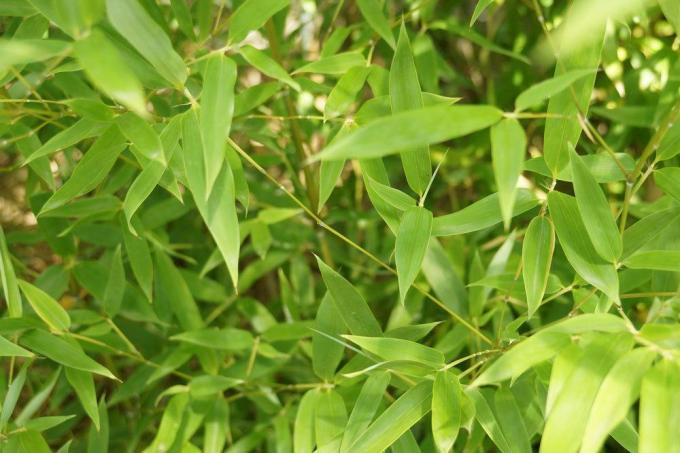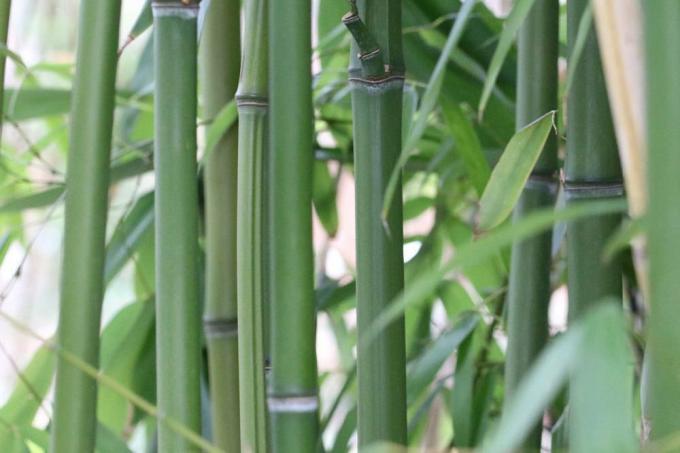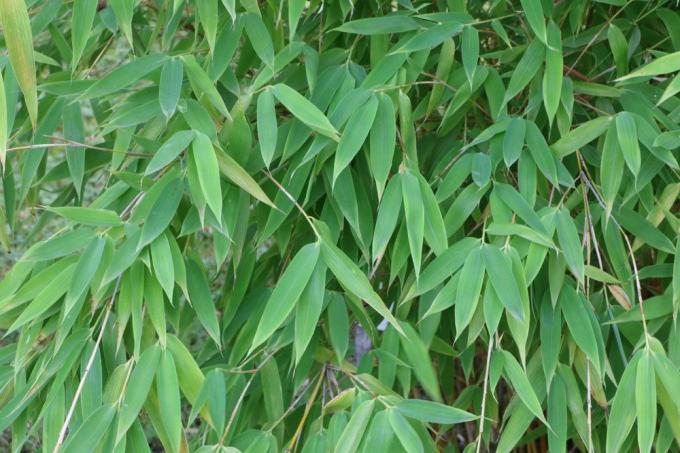
table of contents
- Bamboo species
- growth
- Growth behavior
- From Fargesia
- From Phyllostachys
- From pleioblastus
- From Sasa and Sasella
- From Pseudosasa
- growth
Bamboo is one of the fastest growing plants and many species are fully grown after a few months or even weeks. With over a hundred hardy species, the Bambusoideae are more common in home gardens than Privacy protection, in Asian garden concepts or in individual positions as a special eye-catcher to be found. For many interested parties, this naturally raises the question of how fast the bamboo grows and when does it reach its full height?
Bamboo species
Grasses as tall as trees
All bamboo species are from the Poaceae genus, which have their origins in tropical, subtropical and warm-temperate climates. They can be found on every continent except Europe and of course Antarctica, and some species reach heights of stature that are just gigantic. The giant bamboo holds the record with a height of 48 meters. Such growth is only possible due to the permanently warm tropical weather. Due to the cool temperatures in Central Europe, we are specifically referring to the genera that are used for suitable for cultivation in Germany, but clearly smaller due to the climatic conditions stay.

Fargesia
- 100-500 centimeters
Phyllostachys
- 600 - 1,200 centimeters
Pleioblastus
- 40 - 150 centimeters
Sasa and Sasaella
- 30 - 200 centimeters
Pseudosasa
- an average of 400 centimeters
Note: The lucky bamboo (Dracaena sanderiana) is not listed here because this plant is not a bamboo. Dracaena sanderiana are snake lilies that resemble bamboo stalks due to their growth shape, but are not related to each other.

growth
How fast does bamboo grow?
Bamboo inspires people with its speed of growth, because many types of bamboo, including Fargesia, reach their final height within four to six weeks. Varieties of the genus Phyllostachys, on the other hand, need several years, especially in Central Europe, before they have reached their stately size of up to ten meters. Since there are more than 1,400 species, it is impossible to say in general how fast bamboo grows, since it also grows faster in tropical regions than in Germany. In Baden-Württemberg alone, bamboo grows almost twice as fast as in northern Germany. This is the average bamboo growth rate in Germany per day (based on experience).
Fargesia species
- 2.5 to 3.5 centimeters
Phyllostachys species
- 15 to 25, less often 30 centimeters
Pseudosasa
- 2.5 to 5 centimeters
Sasa / Sasaella / Pleioblastus
- no information, finished growth after about a month

Growth behavior
From Fargesia
Fargesia is a bamboo genus that provides numerous varieties that vary in height between one and five meters. Fargesia robusta 'Campbell' is the tallest Fargesia species in Germany and can grow to over five meters after about four years. The growth of Fargesia is described as follows.
- fully grown after four to six weeks
- in the following years between 100 and 120 percent growth per season
- Rhizomes do not sprout, so no rhizome barrier is required
- grows as a compact perennial
- is suitable as a privacy screen or for dividing the garden
Tip: If you have a garden bamboo in your garden and it has sprouts, you can eat it raw. They are extremely healthy and tasty.
From Phyllostachys
The genus Phyllostachys is particularly popular with three species.
- Black reed bamboo (Phyllostachys nigra)
- Moso bamboo (Phyllostachys edulis)
- Golden bamboo (Phyllostachys aurea)
The black pipe bamboo was in the 19th Bamboo was brought to Europe in the 19th century and is known for its deep black stalks. Phyllostachys species grow as described below.
- within the first two weeks they reach heights of about 40 centimeters
- then faster growth as indicated above
- can sprout up to seven meters or more in the first eight weeks
- grow by 150 percent per year in Germany
- need rhizome barrier
- are mainly used as decorative bamboo in the garden

From pleioblastus
Did you know that there are even types of bamboo that are suitable as ground cover? The genus Pleioblastus produces a multitude of species that only reach low heights in Germany and that are more broad in shape and grow as follows.
- reaches its final size within a few weeks
- grows only slowly in the years to come
- but extremely robust
- requires rhizome barrier
From Sasa and Sasella
The two genera Sasa and Sasella belong to the dwarf bamboo genera and reach heights between 30 and 200 centimeters on German soil. The growth is similar to that of pleioblastus.
- reach full height after about four to five weeks
- stronger growth in the following year
- also robust
- Rhizome barrier necessary
- can be kept in the pot without any problems
Tip: You can distinguish Sasa and Sasaella by looking at the leaves. While Sasa has broad leaves and shorter shoots, Sasaella is exactly the opposite.
From Pseudosasa
Pseudosasa japonica is known in this country as arrow bamboo and grows as follows in Germany.
- sprouts quickly in the first five weeks
- can reach about 180 centimeters in the first year
- grows by 150 percent in the following years
- requires rhizome barrier

growth
What is behind the growth of the bamboo?
The secret behind the unique growth of the bamboo plants lies in the combination of the hollow body inside the plant and the macromolecule lignin. Lignin is also an essential component in wood and ensures that the fibers are robust and durable. Bamboo stalks are hollow and can therefore easily grow tall and even withstand gusts of wind without breaking. This is because the cavity reduces the tension on the fibers and so the bamboo swings with the wind. The entire life force of the plant is anyway in the rhizomes, which run underground and supply the plant.



